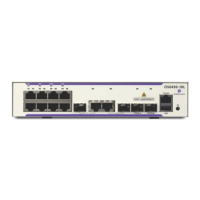Configuring VLAN Stacking Configuring VLAN Stacking Services
OmniSwitch AOS Release 7 Network Configuration Guide March 2011 page 27-17
Use the no form of the ethernet-service sap cvlan command to delete an association between customer
traffic and a VLAN Stacking SAP. For example, the following command deletes the association between
CVLAN 500 and SAP 20:
-> no ethernet-service sap 20 cvlan 500
Note that when the last customer traffic association is deleted from a SAP, the SAP itself is not automati-
cally deleted. No traffic is accepted or processed by a SAP in this state, but the SAP ID is still known to
the switch.
Consider the following when configuring the type of customer traffic to tunnel:
• If no customer traffic is associated with a VLAN Stacking SAP, then the SAP does not process any
traffic for the service.
• Only one all or untagged designation is allowed for any given SAP; specifying both for the same SAP
is not allowed.
• Only one untagged designation is allowed per UNI port, even if the UNI port is associated with multi-
ple SAPs.
• Only one all designation is allowed per UNI port, even if the UNI port is associated with multiple
SAPs.
Use the show ethernet-service command to display the type of customer traffic associated with each SAP
configured for the switch
Configuring a Service Access Point Profile
The ethernet-service sap-profile command is used to create a VLAN Stacking service access point (SAP)
profile. The following command parameters define the traffic engineering attributes that are applied to
customer traffic that is accepted on UNI ports associated with the SAP profile:
Profile Attribute Command Parameters Description
Ingress bandwidth shar-
ing
shared | not shared Whether or not ingress bandwidth is shared
across UNI ports and CVLANs.
Ingress rate limiting ingress-bandwidth The rate at which customer frames ingress on
UNI ports.
Egress rate limiting egress-bandwidth The rate at which customer frames egress on
UNI ports.
Bandwidth assignment bandwidth not-assigned Allows QoS policy rules to override profile
attribute values for bandwidth. By default, the
profile bandwidth values take precedence and are
allocated additional QoS system resources.
Double-tag or translate cvlan | preserve | trans-
late
Determines if a customer frame is tagged with
the SVLAN ID (double-tag) or the CVLAN ID is
changed to the SVLAN ID (translate) when the
frame is encapsulated for tunneling. Double-tag
is used by default.

